Introduction
Physical exercise is definitely a vital lifestyle consideration that many people seek together with polyphasic sleeping. In general, activities which involve only light-to-moderate exercise (e.g. light cardio or light sports) should not have any significant impact on sleep architecture except in extreme polyphasic schedules.
However, very physically strenuous activities or high-intensity exercises (e.g. heavy sports, weight lifting, HIIT, etc.) should be considered more carefully.
- Additional sleep time is a requirement because muscles and tissues need repairing. In addition, this observation holds true at least for teenagers. Overall, it may reflect an increase in daily SWS requirement1.
- The increase in SWS usually causes a reduction in the total time spent in NREM21.
- The total amount of possible daily sleep reduction for highly physically active people reduces, because they require more sleep overall.
Moreover, many people engaging in high levels of exercising can reportedly take on a polyphasic schedule with 3 uninterrupted core cycles (4.5 hours) without any problems, based on our experience.
Exercise Tips during Adaptation
- Additional naps compared to the standard schedules will be critical to allow for more SWS over REM in the core. The difference is noticeable between E2 and E3-extended, for example.
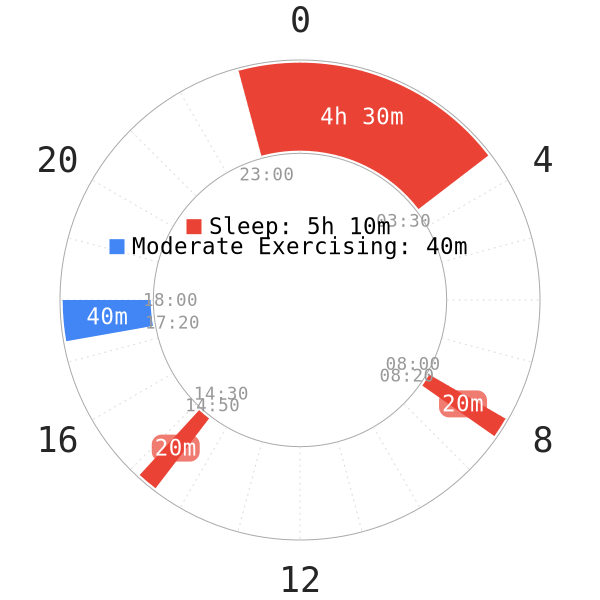
- During adaptation, it is best to not raise the SWS need unnecessarily. This could lead to an elevated risk of entering an SWS rebound. Typically, you can continue the familiar level of physical exertion after you have fully adapted to your new sleep schedule.
- While significant muscle and tissue repairing generally increases sleep duration2, exercise and an active lifestyle can reduce feeling of constant tiredness. However, some inactive people experience tiredness on regular sleep schedules longer than general recommendation.
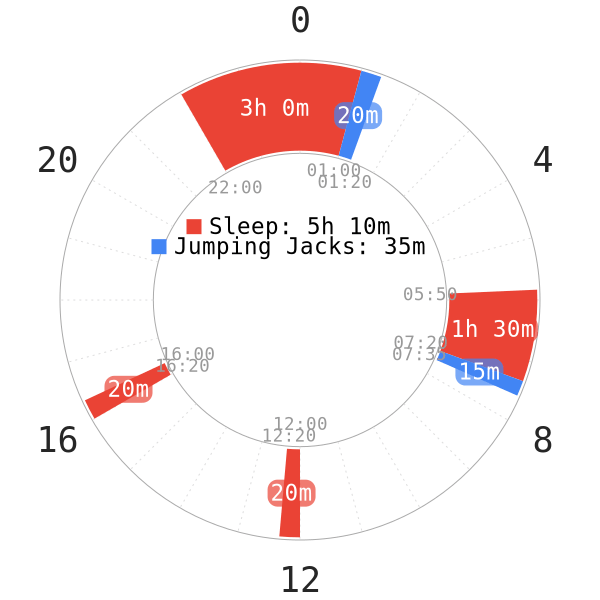
- Many people also find physical activity helpful during adaptation; some forms of exercising can help combat the urge to sleep. Especially during the second and third adaptation stage, oversleeps are mostly present with inactivity.
Exercise Tips after Adaptation
- After adaptation, sporadically increasing the length of the core by one full cycle to support more exercise is possible. However, this should not be too often. Some decompression or adaptation setback can occur, which can take a few days to bounce back.
- Extending the core once a week at most will greatly stabilize your sleep schedule and prevent significant fluctuations in energy or oversleeping chances.
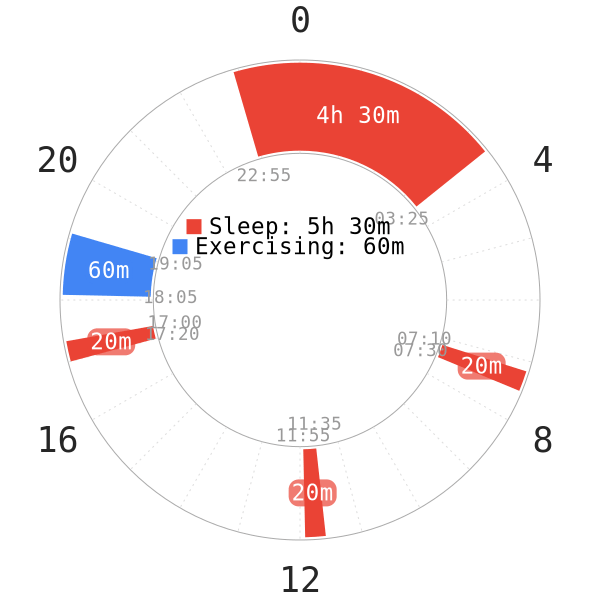
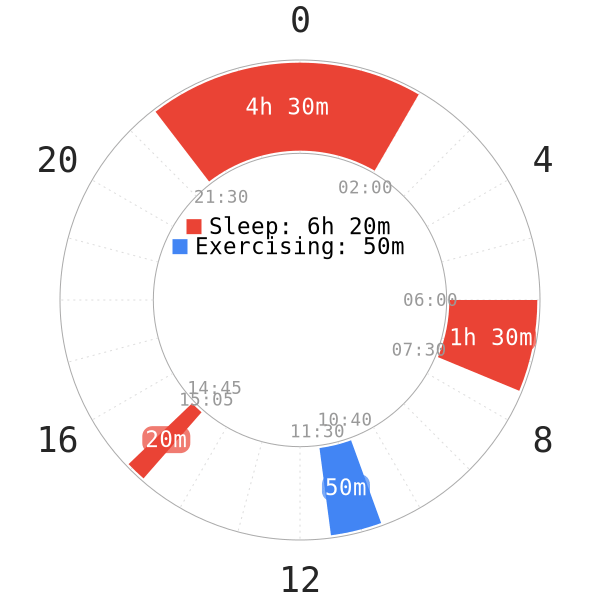
- Placing an exercise too close to a sleep block can also heavily affect sleep quality. In case an exercise session ends no more than 1 hour before bedtime, the following detrimental effects occur3:
- Sleep onset duration may increase. This is because of an increase in heart rate, which activates the sympathetic nervous system.
- Inflated total sleep time because of slower onset of vital sleep.
- Sleep fragmentations are also more prevalent; however, these may be less relevant on more reducing polyphasic schedules.
- However, there may be some variability in different exercise regimes and intensity levels; the above observations, which are from monophasic sleepers, may vary for polyphasic sleepers.
- Considering everything, it is best to leave a gap of at least 2h between exercise and before sleep.
- Regardless, if you know a shorter exercising window does not hinder your sleep, you can ignore the above rules.
Due to a significant SWS deprivation during adaptation on schedules with extreme levels of sleep reduction, especially nap-only schedules with severe SWS rebounds during adaptation, you should avoid overexertion.
It may take extra time to recover even after light or moderate levels of exercise, especially with a physically active job. After the adaptation period, this effect should be less noticeable, but will likely persist on extreme schedules.
Most Suitable Polyphasic Schedules for Exercising
Although the assessment is not foolproof, it is worth considering when you want to pursue a physically active lifestyle. If you have low SWS requirement, you may be able to get away with less sleep and an overall active lifestyle.
- Note that extended versions are much more hospitable for exercising.
- The table only lists some polyphasic schedules with some reported exercise levels.
- Short sleepers are included in the list, for those who have adapted to a nap-only schedule.
| Polyphasic Schedule Groups | Notable Schedules | Exercise Sustainability |
| Biphasic | Segmented | |
| E1 | ||
| Siesta | ||
| Biphasic-X | ||
| E2 | ||
| E3-extended | ||
| E4-extended | ||
| SEVAMAYL | ||
| Dual Core | DC1 | |
| DC2 | ||
| DUCAMAYL | ||
| Tri Core | Triphasic-extended | |
| Core-only | QC0 | |
| CAMAYL | ||
| Nap-only | Uberman | |
| Dymaxion | ||
| SPAMAYL |
Brief analysis
- Biphasic schedules are the most common for exercising. This is because they often offer the most sleep. Siesta, however, is currently the best schedule in the Biphasic group for exercising. However, the reducing versions are less stellar than non-reducing or extended equivalents.
- Everyman variants with a core sleep of at least 3 full sleep cycles can support moderately intense, somewhat regular exercising well.
- Dual Core variants with at least 2 full sleep cycles for an SWS core can give adequate physical recovery.
- However, among Tri Core schedules, only Triphasic-extended is hospitable for regular exercising. This is because the other variants have an overall low amount of sleep and/or scheduling constraints.
- Uberman and Dymaxion are the most popular nap-only schedules. While short/insomniac sleepers could complete the adaptation, their recovery rate remains slower than usual. In addition, their overall exercise regime is far from intense/regular.
- The most exercise-friendly schedules often require at least ~5h of total sleep, assuming normal SWS requirements.
- Recently, there are also reports that multi-core schedules may even provide faster regeneration than single-core schedules. It is unknown why; having an SWS-concentrated core (especially for extended variants like Triphasic) can easily secure daily SWS and REM requirements.
Important Notes
- Exercising can contribute mildly to establishing the circadian rhythm by setting the new circadian morning4.
- There should be no heavy exercising during the dark period, although the circadian effect is minor compared to light exposure.
- Night shift workers may opt to use exercise as a way to favorably shift their circadian rhythm. This would serve to better accommodate for their sleep and work schedule.
Growth Hormone
Human growth hormone (HGH) is a hormone that affects skeletal muscle growth5-6 and skeletal growth7-8. It is, therefore, very important that adolescents and children produce a sufficient amount.
- SWS in the first sleep cycle typically secretes HGH9. Oftentimes, this isn’t an issue for polyphasic sleepers who follow the sleep recommendations of this guide. Thus, they should always have a core dedicated to SWS; therefore, they will achieve the necessary, uninterrupted SWS for adequate HGH release.
- Getting an adequate amount of sleep will promote muscle growth. This is because lack of SWS otherwise will lead to no gains. Refer to Uberman for a story on working out and stunted gains.
- On another spectrum, this evidence strengthens the idea that adolescents should never attempt nap-only schedules. Such a sleeping schedule can severely butcher their own GH.
Growth Hormone & Exercising
- After some ~1.5h of low-medium endurance training, the GH can also show an increase in SWS duration in the siesta (both 60m and 90m)10.
- While it may be acceptable to exercise before a long daytime core sleep, doing so before a short nap (~20m) may incur SWS wakes near the end of the nap. More specifically, the 20m nap may not be long enough to finish providing all necessary SWS.
- After some workout, the body may become exhausted and need recovery. This is also why some people find it easy to fall asleep after a rather intense exercise session. This is a result of more SWS pressure going into the nap to secrete GH and foster tissue repair.
- Daytime exercising may also explain why certain short polyphasic naps contain SWS, especially during later daytime hours.
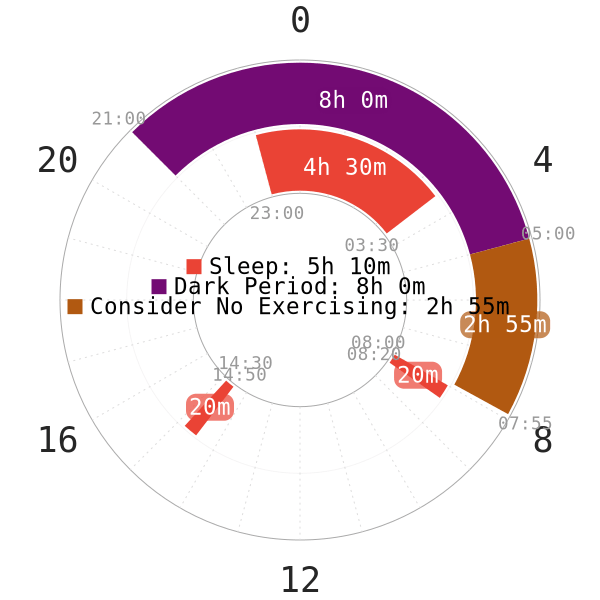
- You should not exercise before a REM-filled nap because of the possible induction of some SWS.
- Specifically, even if your dark period ends before the first nap on an Everyman schedule, consider moving your exercise time to after the nap instead.
- Nonetheless, if you find out that your schedule is crunched and some exercising before the nap does not affect your REM duration, you may incorporate some low-medium-intensity exercises.
- Exercising can stimulate a dramatic increase in GH release for 105-145 minutes11 after a workout session.
- GH response is also independent of time of day.
- Furthermore, after this spike in GH release, there is a direct suppression of GH release for a period of ~55-90 minutes11. Though your mileage may vary, it goes to show that you can avoid SWS wakes in your naps by waiting for ~3-4h to nap after your workout.
Main author: Crimson & GeneralNguyen
Page last updated: 30 March 2021
Reference
- Dworak M, Wiater A, Alfer D, Stephan E, Hollmann W, Strüder H. Increased slow wave sleep and reduced stage 2 sleep in children depending on exercise intensity. Sleep Med. 2008;9(3):266-272. [PubMed]
- Dattilo M, Antunes H, Medeiros A, et al. Sleep and muscle recovery: endocrinological and molecular basis for a new and promising hypothesis. Med Hypotheses. 2011;77(2):220-222. [PubMed]
- Stutz, J., Eiholzer, R., & Spengler, C. M. (2018). Effects of Evening Exercise on Sleep in Healthy Participants: A Systematic Review and Meta-Analysis. Sports Medicine. doi:10.1007/s40279-018-1015-0.
- YAMANAKA Y, HONMA K, HASHIMOTO S, TAKASU N, MIYAZAKI T, HONMA S. Effects of physical exercise on human circadian rhythms. S. 2006;4(3):199-206. doi:10.1111/j.1479-8425.2006.00234.x
- Fellenius E, Hansen C, Mjøs O, Neely J. Chronic infarction decreases maximum cardiac work and sensitivity of heart to extracellular calcium. Am J Physiol. 1985;249(1 Pt 2):H80-7. [PubMed]
- Gosteli-Peter M, Winterhalter K, Schmid C, Froesch E, Zapf J. Expression and regulation of insulin-like growth factor-I (IGF-I) and IGF-binding protein messenger ribonucleic acid levels in tissues of hypophysectomies rats infused with IGF-I and growth hormone. Endocrinology. 1994;135(6):2558-2567. [PubMed]
- Hiatt N, Yamakawa T, Davidson M. Necessity for insulin in transfer of excess infused K to intracellular fluid. Metabolism. 1974;23(1):43-49. [PubMed]
- Olney R. Regulation of bone mass by growth hormone. Med Pediatr Oncol. 2003;41(3):228-234. [PubMed]
- Van C, Plat L. Physiology of growth hormone secretion during sleep. J Pediatr. 1996;128(5 Pt 2):S32-7. [PubMed]
- Daniel J., D., Kenneth S., G., & Chin Moi, C. (2010). The Effect of Prior Endurance Training on Nap Sleep Patterns; 5(1), 87–97. doi:10.1123/ijspp.5.1.87.
- Kanaley, J. A., Weltman, J. Y., Pieper, K. S., Weltman, A., & Hartman, M. L. (2001). Cortisol and Growth Hormone Responses to Exercise at Different Times of Day1. The Journal of Clinical Endocrinology & Metabolism, 86(6), 2881–2889. doi:10.1210/jcem.86.6.7566.
